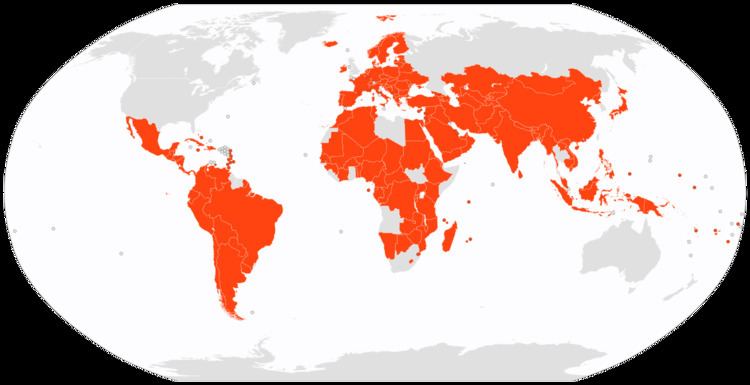Signed 17 October 2003 Effective 20 April 2006 Ratifiers 171 | Location Paris Condition 30 ratifications | |
 | ||
Depositary Director-General of UNESCO | ||
The Convention for the Safeguarding of the Intangible Cultural Heritage is a UNESCO treaty adopted by the UNESCO General Conference on 17 October 2003. The convention entered into force in 2006, after thirtieth instruments of ratification by UNESCO Member States. As of September 2016, 171 states have ratified the convention.
Contents
Layout of the Convention
The Convention contains following provisions:
I. General Provisions
II. Organs of the Convention
III. Safeguarding of the intangible cultural heritage at the national level
IV. Safeguarding of the intangible cultural heritage at the international level
V. International cooperation and assistance
VI. Intangible Cultural Heritage Fund
VII. Reports
VIII. Transitional clause
IX. Final clauses
Purposes of the Convention
Unlike other UNESCO conventions, this convention begins with stating its purposes, which are;
(a) to safeguard the intangible cultural heritage;
(b) to ensure respect for the tangible cultural heritage of the communities, groups and individuals concerned;
(c) to raise awareness at the local, national and international levels of the importance of the intangible cultural heritage, and of ensuring mutual appreciation thereof; (d) to provide for international cooperation and assistance.
Definition
Intangible cultural heritage refers to "traditions or living expressions inherited from our ancestors and passed on to our descendants, such as oral traditions, performing arts, social practices, rituals, festive events, knowledge and practices concerning nature and the universe or the knowledge and skills to produce traditional crafts". The Convention defines it as follows:
Intangible Cultural Heritage means the practices, representations, expressions, knowledge, and skills – as well as the instruments, objects, artifacts and cultural spaces associated therewith – that communities, groups and, in some cases, individuals recognize as part of their cultural heritage. This intangible cultural heritage, transmitted from generation to generation, is constantly recreated by communities and groups in response to their environment, their interaction with nature and their history, and provides them with a sense of identity and continuity, thus promoting respect for cultural diversity and human creativity. For the purposes of this Convention, consideration will be given solely to such intangible cultural heritage as is compatible with existing international human rights instruments, as well as with the requirements of mutual respect among communities, groups and individuals, and of sustainable development.
Function
The Convention works on both national and international levels. At the national level, State Parties are supposed to ‘take necessary measures to ensure the safeguarding of the intangible cultural heritage present in its territory.” These measures include identification of the intangible cultural heritage that exists in its territory, adoption of appropriate policies, promotion of education and so on. Besides, in taking these measures, each state parties must “endeavor to ensure the widest possible participation of communities, groups, and, where appropriate, individuals that create, maintain and transmit such heritage, and to involve them actively in its management”.
At the international level, this Convention promotes international cooperation, which includes “the exchange of information and experience, joint initiatives, and the establishment of a mechanism of assistance” to other State Parties.
Lists
The Committee to the Convention publishes and keeps up to date two lists of intangible cultural heritage, which are
Intangible Cultural Heritage Fund
The Convention establishes Intangible Cultural Heritage Fund, the use of which is decided by the Committee. The fund mainly consists of the contributions by State Parties and funds by the General Conference of UNESCO.
Precursors
One of the first international occasions that mentioned the preservation of 'intangible heritage' was the World Conference on Cultural Policies in Mexico City in 1982. This Conference defined cultural heritage as including “both tangible and intangible works through which the creativity of people finds expression,” and asked UNESCO and Member States to take measures for protecting this kind of heritage.
In 1989, UNESCO adopted the Recommendation on the Safeguarding of Traditional Culture and Folklore as the first legal instrument towards the safeguarding of intangible cultural heritage. This Recommendation reflected the ideas of the earlier Conference in Mexico City. UNESCO conducted some promotional programs for raising awareness of this Recommendation, but was not very successful. However, in the late 90's, there was a conference held for the assessment of this Recommendation, which pointed out some problems to be considered in drafting the Convention. In this sense, this Recommendation served as an important step.
In 1997, UNESCO launched the program of Proclamation of the Masterpieces of the Oral and Intangible Heritage of Humanity, intending to raise awareness of the importance of intangible heritage. This program proclaimed a total of 90 masterpieces between 2001 and 2005, and caused the movement toward the Convention.
Creation
According to the request of Member States, a preliminary study, undertaken by Director-General, on how could the safeguarding of intangible cultural heritage be conducted, recommended to create a new document that set an international standard.
In 2001, the General Conference adopted another instrument, Universal Declaration on Cultural Diversity, which also includes articles dealing with the preservation of ’heritage in all forms’. This declaration and its Action Plan presented basic idea of the coming convention and helped to develop it.
As a result of many meetings for two years, the draft Convention was brought into the General Conference and adopted in 2003.
